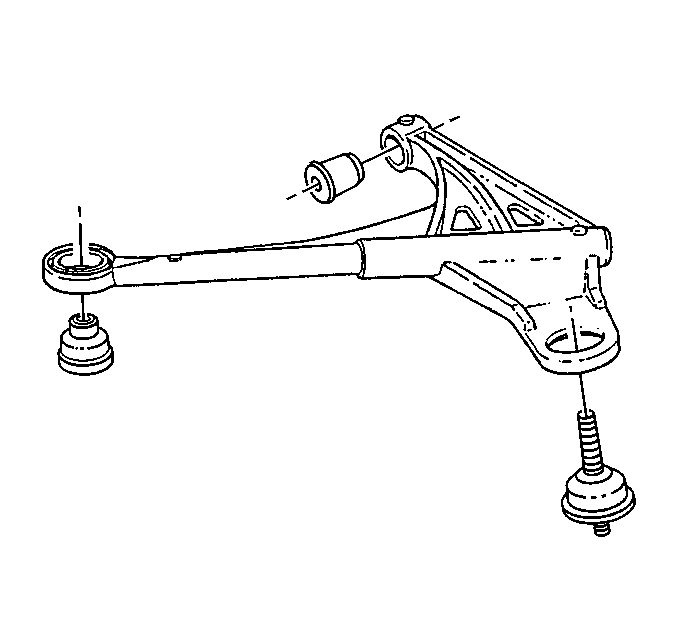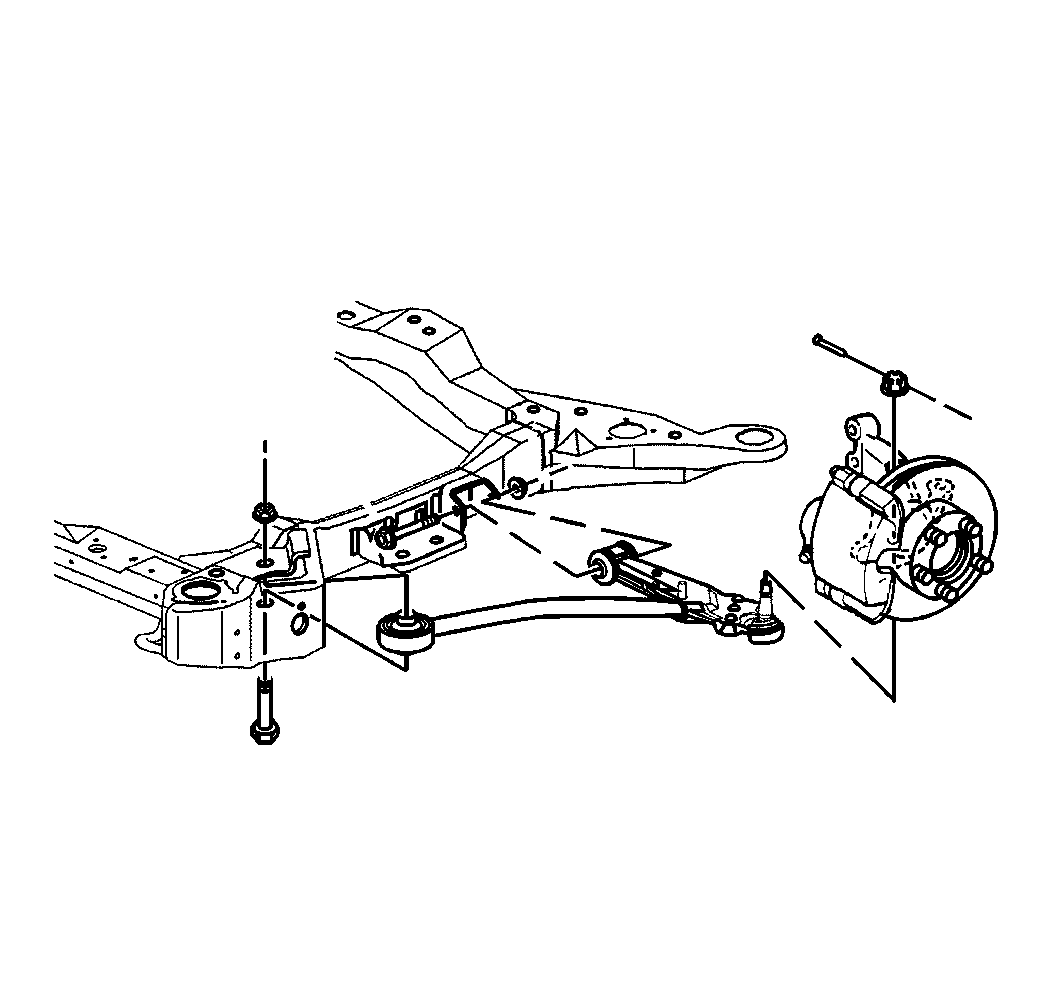Lower Control Arm Replacement With B9Q/V4U
Removal Procedure

- Raise the vehicle. Refer
to
Lifting and Jacking the Vehicle
in General Information.
- Remove the tire and wheel. Refer to
Tire and Wheel Removal and Installation
in Tire and Wheels.
- Remove the road sensing suspension position sensor from the lower
control arm.
- Separate the ball joint from the lower control arm. Refer to
Lower Control Arm Ball Joint Replacement
With V4U/B9Q.
- Remove the lower control arm bushing bolt, brake reaction rod
nut, retainer and insulator.
- Remove the lower control arm from frame.
Installation Procedure

- Install the lower control
arm to the frame.
- Install the lower control arm bushing bolt, brake reaction rod
nut, retainer and insulator. Do not tighten at this time.
Notice: Use the correct fastener in the correct location. Replacement fasteners
must be the correct part number for that application. Fasteners requiring
replacement or fasteners requiring the use of thread locking compound or sealant
are identified in the service procedure. Do not use paints, lubricants, or
corrosion inhibitors on fasteners or fastener joint surfaces unless specified.
These coatings affect fastener torque and joint clamping force and may damage
the fastener. Use the correct tightening sequence and specifications when
installing fasteners in order to avoid damage to parts and systems.
- Install the ball
joint to the steering knuckle.
Tighten
Tighten the ball joint nut to 175 N·m (129 lb ft).
- Install the road sensing suspension position sensor to the lower
control arm.
- Instal the tire and wheel assembly.
Tighten
Tighten the wheel nuts to 140 N·m (100 lb ft).
- Lower the vehicle and allow the vehicle to assume proper trim
height.
Tighten
| • | Tighten the control arm bushing nut to 126 N·m (94 lb ft). |
| • | Tighten the control arm bushing horizontal bolt to 157 N·m
(116 lb ft). |
| • | Tighten the brake reaction rod nut to 126 N·m (116 lb ft). |
Lower Control Arm Replacement Without B9Q/V4U
Removal Procedure
Tools Required
- Raise the vehicle and support the frame with jack stands. Refer
to
Lifting and Jacking the Vehicle
in General Information.
Notice: Care must be exercised to prevent Tri-Pot joints from being over-extended.
When either end of the shaft is disconnected, over-extension of
the joint could result in separation of internal components and possible joint
failure. Drive axle joint seal protectors should be used any time service
is performed on or near the drive axles. Failure to observe this can result
in interior joint or seal damage and possible joint failures.
- Remove
the tire and wheel assembly. Refer to
Tire and Wheel Removal and Installation
in Tires and Wheels.
- Remove the Road Sensing Suspension position sensor from the lower
control arm.

- Separate the lower ball
joint from the steering knuckle using the J 35315
Ball Stud Separator.
- Push the strut knuckle assembly rearward.
- On the left control arm, support the transaxle with a screw jack
and a wood block.
| 6.1. | Remove the two transaxle mount nuts. |
| 6.2. | Raise the transaxle with the screw jack to access the control
arm bolt. |
- Remove the control arm forward and rearward nut and bolts.
- Remove the control arm from the frame.
Installation Procedure

- Install the control arm
to the frame.
- Install the control arm forward and rear attachment. Do not tighten.
- Install the transaxle mount in position and lower the transaxle.
Remove the screw jack.
Notice: Use the correct fastener in the correct location. Replacement fasteners
must be the correct part number for that application. Fasteners requiring
replacement or fasteners requiring the use of thread locking compound or sealant
are identified in the service procedure. Do not use paints, lubricants, or
corrosion inhibitors on fasteners or fastener joint surfaces unless specified.
These coatings affect fastener torque and joint clamping force and may damage
the fastener. Use the correct tightening sequence and specifications when
installing fasteners in order to avoid damage to parts and systems.
- Install the lower
ball joint to the knuckle.
Tighten
Tighten the ball joint nut to 10 N·m (84 lb in)
using the J 35551
Ball
Stud Nut Wrench 90 degrees to the torque wrench. Tighten the nut and
additional 120 degrees. When tightening the nut a minimum torque of 50 N·m
(37 lb ft) must be obtained. If 50 N·m (37 lb ft)
is not obtained, inspect the nut for stripped threads. If the threads
are satisfactory, replace the ball joint and the knuckle. If required,
turn the nut up an additional 60 degrees in order to allow for the installation
of the cotter pin.
- Install the Road Sensing Suspension position sensor to the lower
control arm.
- Install the tire and wheel assembly. Refer to
Tire and Wheel Removal and Installation
in Tires
and Wheels.
Tighten
Tighten the wheel nuts to 140 N·m (100 lb ft).
- Lower the vehicle and allow the vehicle in order to assume proper
trim heights.
Tighten
| • | Tighten the control arm rear bolt to nut to 157 N·m
(116 lb ft). |
| • | Tighten the control arm forward bolt to nut to 126 N·m
(93 lb ft). |




